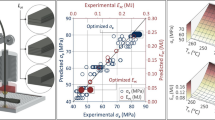Abstract
A common type of thermoplastic elastomer is a blend of styrene-ethylene-butylene-styrene copolymer (SEBS) with polypropylene and mineral oil. The knowledge about the processing parameters that influence the blend of these components is important to achieve the best material properties. In this study, were evaluated the influence of screw configuration (low and high shear) and speed (200, 300, and 400 rpm), molding form (compression and injection) and SEBS type (high and low molecular weight). The specimens were characterized according to their morphology, crystallinity, thermomechanical and mechanical properties. Samples processed in a screw with more kneading zones had a lower modulus value. Compression molded specimens had lower mechanical performance than injected samples. Samples prepared with low molecular weight SEBS presented a loss of mechanical properties. It was possible to correlate processing form with all the properties evaluated. The analyzed variables influenced the morphology, crystallinity and thermomechanical properties, but had low influence on the tensile properties.







Similar content being viewed by others

References
Allen NS, Edge M, Wilkinson A, Liauw CM, Mourelatou D, Barrio J, Martínez-Zaporta MA (2001) Degradation and stabilisation of styrene-ethylene-butadiene-styrene (SEBS) block copolymer. Polym Degrad Stabil 71:113–122. doi:10.1016/S0141-3910(00)00162-2
Sengers WGF (2005) Rheological properties of olefinic thermoplastic elastomer blends. Dissertation, Delft University of Technology, Delf, The Netherlands
Sengupta P (2004) Morphology of olefinic thermoplastic elastomers blends. Dissertation, University of Twente. Enschede, The Netherlands
Drobny JG (2007) Handbook of thermoplastic elastomers. William Adrew Publishing, New York
Setz S, Stricker F, Kressler J, Duschek T, Mulhaupt R (1996) Morphology and mechanical properties of blends of lsotactic or syndiotactic polypropylene with SEBS block copolymers. J Appl Polym Sci 59:1117–1128. doi:10.1002/(SICI)1097-4628(19960214)59:7<1117:AID-APP8>3.0.CO;2-H
Bassani A, Pessan LA, Hage E (2001) Toughening of polypropylene with styrene/ethylene-butylene/styrene tri-block copolymer: effects of mixing condition and elastomer content. J Appl Polym Sci 82:2185–2193. doi:10.1002/app.2066
Kim K-N, Kim H, Lee JW (2001) Effect of lnterlayer structure, matrix viscosity and composition of a functionalized polymer on the phase structure of polypropylene–montmorillonite nanocomposites. Polym Eng Sci 41(11):1963–1969. doi:10.1002/pen.10892
Ohlsson B, Hassander H, Tornell B (1996) Blends and thermoplastic interpenetrating polymer networks of polypropylene and polystyrene-block-poly(ethylene-stat-butylene)-block-polystyrene triblock copolymer 1: morphology and structure-related properties. Polym Eng Sci 36(4):501–510. doi:10.1002/pen.10436
Veenstra H, van Lent BJJ, van Dam J, Boer AP (1999) Co-continuous morphologies in polymer blends with SEBS block copolymers. Polymer 40:6661–6672. doi:10.1016/S0032-3861(98)00875-1
D’Orazio L, Guarino R, Mancarella C, Martuscelli E, Cecchin G (2001) Morphology, crystallization, and thermal behavior of isotactic polypropylene/propylene-g-styrene blends. J Appl Polym Sci 79:2286–2298. doi:10.1002/1097-4628(20010321)79:12<2286:AID-APP1036>3.0.CO;2-0
Nakason C, Kaewsakul W (2010) Influence of oil contents in dynamically cured natural rubber and polypropylene blends. J Appl Polym Sci 115:540–548. doi:10.1002/app.30909
Sengupta P, Noordermeer JWM (2004) Effects of composition and processing conditions on morphology and properties of thermoplastic elastomer blends of SEBS–PP–oil and dynamically vulcanized EPDM–PP–Oil. J Elastom Plast 36:307–331. doi:10.1177/0095244304042668
Cáceres CA, Canevarolo SV (2009) Degradação do polipropileno durante a extrusão e a geração de compostos orgânicos voláteis. Polímeros 19(1):79–84. doi:10.1590/S0104-14282009000100017
Silvano JR, Rodrigues SA, Marini J, Bretas RES, Canevarolo SV, Carvalho BM, Pinheiro LA (2013) Effect of reprocessing and clay concentration on the degradation of polypropylene/montmorillonite nanocomposites during twin screw extrusion. Polym Degrad Stabil 98:801–808. doi:10.1016/j.polymdegradstab.2012.12.009
Tochacek J, Jancar J (2012) Processing degradation index (PDI)—a quantitative measure of processing stability of polypropylene. Polym Test 31:1115–1120. doi:10.1016/j.polymertesting.2012.08.004
Sierra CA, Galán C, Fatou JG, Parellada MD, Barrio JA (1997) Thermal and mechanical properties of poly-(styrene-b-ethylene-co-butylene-b-styrene) triblock copolymers. Polymer 38(17):4325–4335. doi:10.1016/S0032-3861(96)01045-2
Abreu FOMS, Forte MMC, Liberman AS (2005) SBS and SEBS block copolymers as impact modifiers for polypropylene compounds. J Appl Polym Sci 95:254–263. doi:10.1002/app.21263
Chen Y, Ye L (2011) Structure and properties of PP/POE/HDPE blends. J Appl Polym Sci 121:1013–1022. doi:10.1002/app.33706
Ohlsson B, Tornell B (1996) Melt miscibility in blends of polypropylene, polystyrene-block-poiy(ethylene-stat-butylene)-block-polystyrene, and processing oil from melting point depression. Polym Eng Sci 36(11):1547–1555. doi:10.1002/pen.10550
Mendienta-García MB, Páramo-García U, Díaz-ZavalaNP Robledo-Muñiz JG, Rivera-Armenta JL (2013) Thermal and morphological evaluation of linear and radial sebs-polypropylene blends. Polímeros 23(5):597–601. doi:10.4322/polimeros.2013.098
Tadmor Z, Gogos CG (2006) Principles of polymer processing, 2nd edn. Wiley, New Jersey. ISBN: 978-0-471-38770-1
Dumoulin MM (2002) Polymer blends forming. In: Utracki LA (ed) Polymer blends Handbook. Kluwer Academic Publishers, Dordrecht/Boston/London, pp 653–754. ISBN 978-94-007-6065-3
Brydson JA (1999) Plastics Materials, 7th edn. Butterworth-Heinemann, Oxford. ISBN 978-0-7506-4132-6
Nunes RW, Martin JR, Johnson JF (1982) Influence of molecular weight and molecular weight distribution on mechanical properties of polymers. Polym Eng Sci 22(4):205–228. doi:10.1002/pen.760220402
Ronca S, Forte G, Tjaden H, Rastogi S (2015) Solvent-free, solid state processed tapes of UHMWPE: influence of molar mass and molar mass distribution on tensile properties. Ind Eng Chem Res 54(30):7373–7381. doi:10.1021/acs.iecr.5b01469
Biemond GJE, Feijen J, Gaymans RJ (2008) Influence of polydispersity of crystallizable segments on the properties of segmented block copolymers. Polym Eng Sci. doi:10.1002/pen.21115
Acknowledgements
The authors are grateful to Financiadora de Estudos e Projetos (FINEP) for financial support (03.13.0280.00) and Softer Brasil Compostos Termoplásticos LTDA.
Author information
Authors and Affiliations
Corresponding author
Rights and permissions
About this article
Cite this article
Tomacheski, D., Pittol, M., Ermel, C.E. et al. Influence of processing conditions on the mechanical properties of SEBS/PP/oil blends. Polym. Bull. 74, 4841–4855 (2017). https://doi.org/10.1007/s00289-017-1994-2
Received:
Revised:
Accepted:
Published:
Issue Date:
DOI: https://doi.org/10.1007/s00289-017-1994-2



